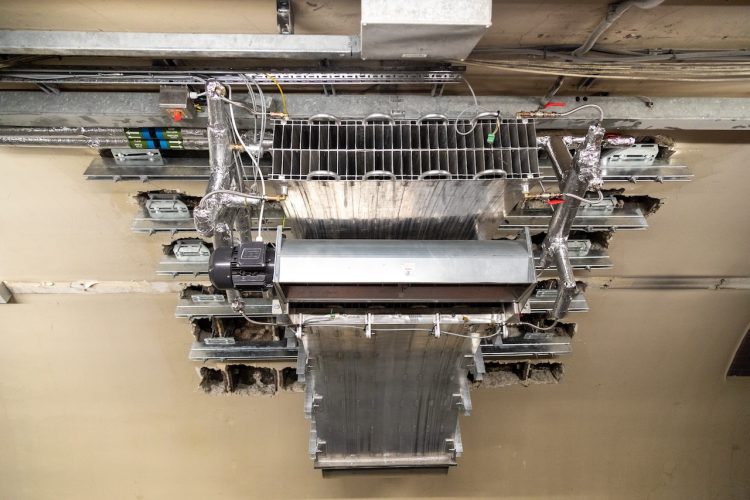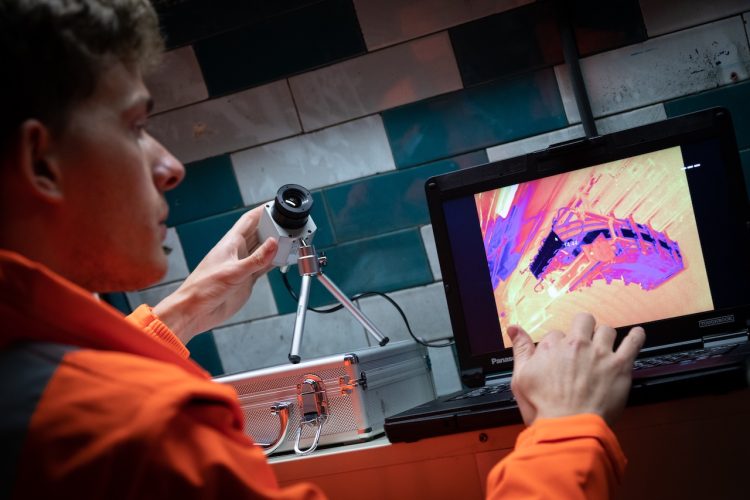Innovative technology is being tested to see if it is suitable for bringing temperatures down for the London Underground network.
As the UK recently endured its hottest temperatures on record, Transport for London‘s trial is perfectly timed and could benefit the deep Tube network including Bakerloo, Central, Jubilee, Northern, Piccadilly, Victoria and Waterloo & City Lines.
The cooling panel could bring cooler air for passengers awaiting trains on platforms alongside mitigating potential temperatures associated with running increased numbers of trains on the Piccadilly line as part of the lines capacity upgrades in the future.
The inventive cooling panel works by circulating cold water through pipework which is inside a curved metal structure in order to chill it. The panels then circulate air via an industrial-sized fan through the gaps in its structure which in turn becomes cooled.
Additional benefits of the panel will see operational and maintenance costs halved when compared to current technology which manages temperatures for Tube lines.

The trial comes as part of the Government’s TIES Living Lab Programme which sees 25 partners working together focusing on 10 infrastructures, data research and digital demonstrator projects.
The cooling panel project has been 70% funded by the Department for Transport and Innovate UK with the convection cooling system designed by Transport for London and developed by SRC Infrastructure which also carried out its construction.
After the trial at Holborn station and subject to funding, Transport for London will investigate whether the panels will offer a cooling solution for other deep Tube lines in the future. Further testing would need to be carried out in a station which is open to customers (Knightsbridge) ahead of Transport for London possibly introducing the technology to four extra stations on the Piccadilly line (Green Park, Holborn, Leicester Square and Piccadilly Circus).
Transport for London may also identify further locations where the panels could provide benefit. Moving forward with the trial at further locations will be subject to Transport for London having enough long-term capital funding available.
The Piccadilly line was selected for the trial as once the new, air-conditioned trains which feature walk-through carriages are brought into use from 2025, the existing fleet will be gradually withdrawn from service and train frequency will be increased during peak hours from 24 to 27 trains per hour from mid-2027. The increase in trains represents a train every 135 seconds during the busiest times and will bring a 23% increase in peak service capacity. Although not currently funded, a line-wide re-signalling would also allow Transport for London to increase train frequencies on the Piccadilly line to 33 and later 36 trains each hour. It is once this point is met that extra cooling at five Piccadilly line stations would be needed, according to Transport for London’s modelling.

Without ongoing long-term investment from the Government, only projects which are currently active or those which are needed to be compliant with safety and other statutory regulations will continue which means there will be no new investment by Transport for London in the transport network. This potential lack of funding would mean that whilst the new Piccadilly line trains which are currently on order and will be honoured, any further orders for Bakerloo and Central line trains to replace the current ageing fleet would see a delay of 10 years until at least 2040.
Lowering temperatures for the deep Tube lines have been challenging in the past due to traditional cooling systems proving to be prohibitively expensive and difficult to put in place in the 120-year-old tunnels and stations. The recent tests on the prototype cooling panel in a laboratory environment have seen air temperatures cut by 10 to 15 degrees. Transport for London is eager to see if this achievement can be repeated on the disused platform at Holborn which mimics the live environment that the panels would be used in.
Paul Judge, TfL’s Project Director for the Piccadilly Line Upgrade, said: “This innovative trial is taking place as we are experiencing record high temperatures. This new technology could play an important role in ensuring we are doing everything we can to protect TfL’s network against future temperature increases, helping to keep staff and customers safe and comfortable.
“The TIES Living Lab project has given us a great collaborative platform for sharing innovative ideas, data and good practice with a range of suppliers. The cooling panel project is supporting the Piccadilly Line Upgrade, which will see new state-of-the-art trains with more space, air-conditioning, walk-through carriages and improved accessibility running at greater frequencies on the line.
“By seeking innovative solutions to cool platforms on the deep Tube network, we will be able to support future Piccadilly line train frequency increases with the possibility that the technology could be used on other Underground lines.”
It is hoped that the new cooling panels would substantially out-perform the current Platform Air Handling Units which are used at some stations on the deep Tube network. Results so far reveal that the panels are much better equipped to operate in the unique conditions of the deep Tube network.





Responses
You mean the former platform that Piccadilly Line trains used to operate the shuttle to Aldwych (Strand).
Yes, effectively a larger version of a car air conditioning system, where incoming air is blown through a small radiator which has the coolant circulated through it. In a car this coolant is a continuously recirculated refrigerant which is continually liquefied and then expanded to gas, absorbing heat as it does so. This heat is dumped to the outside air using another radiator located next to the main engine cooling radiator.
In the case of these cooling panels case though, the coolant is said to be “cold water”. So where does this come from? In the Summer, mains water won’t be cold enough (and even if it was it would lead to a huge once-through use of this water) so I guess the cold water itself will have to be cooled, using some sort of conventional refrigeration system outside of the station environment. It’s not clear why these cooling panels are better than using such a conventional refrigeration system directly.
A sort of ‘car radiator in reverse then’… innovative?